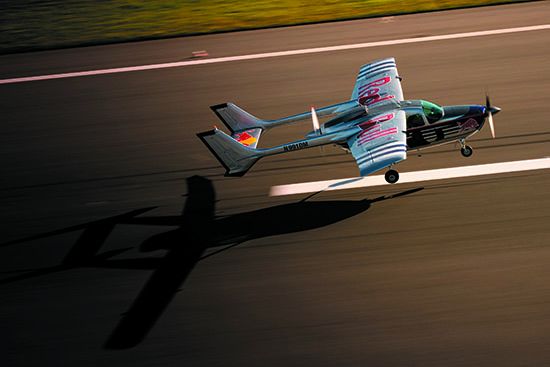For pilots transitioning to twin-engine airplanes, the Cessna Skymaster is often overlooked. Maybe that’s because the airplane is rather unconventional, with a unique design and different handling characteristics than any other twin.
And if you have experience flying a conventional twin, forget everything you know about the “dead foot, dead engine” theory when dealing with an engine failure. Welcome to the world of centerline thrust.
These are different airplanes—and complex ones, too. That means you’ll need to prepare for a healthy level of maintenance, especially for ones that haven’t been cared for as they should. But for those committed to training and upkeep, a Skymaster could be a decent choice, and a real workhorse.
FAR FROM SIMPLE
The idea of the push-pull twin makes such fundamental sense that it has been applied to aircraft designs in one form or another for nearly 100 years and in literally dozens of models you’ve never even heard of.
When Cessna began to develop the Skymaster in the mid-1960s, the accident history was horrid for twins. Part of that was due to training. The doctrine in those days was to actually surprise the pilot with a real engine shutdown to simulate losing one. In the hairy-chested thinking of the day, instructors would even do this on takeoff. As a result, loss-of-control accidents due to VMC rollovers were, if not common, more prevalent then they are today.
In an engine-out situation, conventional piston twins generally need to be handled with kid gloves lest the airplane get too slow and roll over on its back. So Cessna approached this problem just as other designers had going back to the Caproni Ca.1 of 1914: They aligned the two engines with the airframe centerline, offering pilots the safety of a second engine without the penalty of adverse handling. If one quits, identify it, feather it and don’t worry about the dead-foot, dead-engine drill.
Moreover, the FAA even granted the 337 its own class rating, limiting pilots to centerline-thrust twins only. It was much easier—and probably safer—to earn a multi-engine rating in a Skymaster than in a conventional twin.
Part of Cessna’s plan worked, since there’s little question the Skymaster is easier to fly on a single engine than a conventional twin. But, since the VMC rollover accident doesn’t happen that often in the real world because training doctrine moved to zero thrust instead of an actual engine shutdown, the airplane’s overall accident record isn’t that much better than conventional twins.
A pilot looking to improve redundancy by stepping up from a single to a twin certainly will achieve it with a Skymaster. But in the bargain of gaining redundancy, pilots can be forced to accept a platform with more cabin noise, a set of operating peculiarities all its own and tightly packaged systems presenting more of a challenge to maintenance personnel than if each engine resided on its own wing. All of this might argue in favor of a single-engine airplane or even a conventional twin. Then again, if you fly over the Great Lakes at night, maybe not. It’s all about comfort factor, and these days, insurance eligibility. Get a quote before buying one.
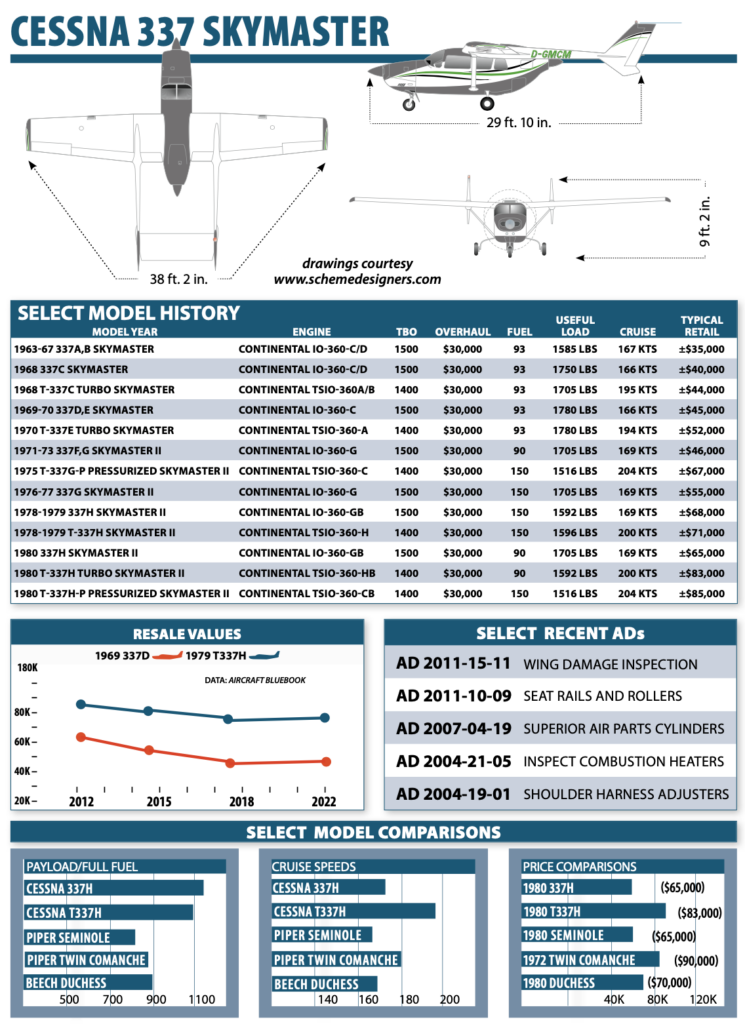
MODEL HISTORY
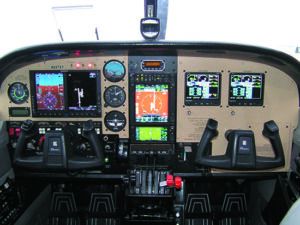
Flash back to 1964 when the Skymaster started life as the fixed-gear Model 336, powered by Continental IO-360-A engines of 195 HP each. But it was widely acknowledged as a slug and Cessna sold only 195 336s in one year of production; less than 100 remain on the FAA’s registry today. In 1965, Cessna made the landing gear retractable and upgraded powerplants to a pair of Continental IO-360-Cs making 210 HP, resulting in the 337 Skymaster. Cessna sold 239 of them that year. (Not really learning from its 336 experience, Cessna flew a cantilever-winged, lower-powered version, the 327, in late 1967, but it proved too slow and the project was dropped the next year.)
To make the 336 Skymaster a retrac, Cessna borrowed the complex and occasionally troublesome hydraulic landing gear system from the 210, of course. But in 1973, it was upgraded to a simpler and more reliable electrohydraulic system. While less complex and easier to maintain, the system still isn’t as robust as, say, a Baron’s or Seneca’s.
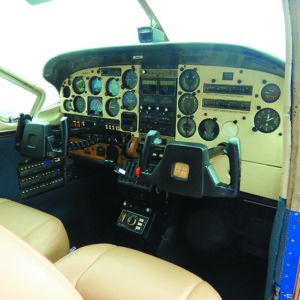
Early models also came with multiple fuel tanks, a system that proved problematic in the field. It was replaced in 1973 by a superior, less complicated system. A turbo version—the T-337B, powered by 210-HP TSIO-360-A or -B engines from Continental—appeared in 1967, but was dropped in 1972 with the addition to the Skymaster line of the almost-revolutionary pressurized 337 version, the T-337G-P, powered by TSIO-360-C engines up-rated to 225 HP.
The turbo reappeared in 1978, with TSIO-360-H powerplants, but Skymaster sales had begun slipping by then. Cessna pulled the plug following the 1980 model year, after a total production run of 2058, plus 332 pressurized versions. In addition, Cessna built slightly more than 500 Skymasters for the U.S. Air Force. These saw extensive action in Vietnam as the O-2A. This version boasts structural beef-ups, hard points and extra windows. These airplanes frequently appear on the used market and may we’ll be the least expensive warbirds available. Additionally, some civilian models were converted to an O-2B configuration for the military to use in psychological warfare.
Major tweaks in the airplane’s history were few, but there were many designation changes. Beginning in 1970, some inspection panels were added—making maintenance easier—and the airframe was lightened a bit, increasing useful load. The interior arrangement also changed through the years, with various combinations of seat mounting.
As is common with any aircraft, the non-pressurized 337’s gross weight crept up during its years in production. Early models started at around 4200 pounds; late ones weighed 4630 pounds, with max landing weight limited to 4400 pounds. Meanwhile, the P-337, with its 30 extra horsepower, had a takeoff weight of 4700 pounds and max landing weight of 4465 pounds.
As of early 2022, piston-twin prices haven’t skyrocketed like singles have, and the 337 is no exception. In fact, we actually found that Aircraft Bluebook prices (what we consider a starting-price reference) for all Skymaster models are slightly down from when we looked at these aircraft a few years ago. On the upside, most of the depreciation has been squeezed out of these airframes, although in the current market who knows what the future holds? But a Skymaster is a lot of airplane for the money. Besides current fuel prices and future uncertainties, other factors depressing prices are that the 337 has a reputation for being heavy on maintenance—one that’s not entirely deserved—and they aren’t speed demons like some other twins.
Caveat emptor—buying a cheap twin is not the same as operating a twin cheaply. A hangar queen will eat through a bunch of money if it needs remedial work and, in any case, you’ll need to find a shop familiar with the breed to do the prebuy and maintain the airplane going forward. The Skymaster doesn’t perform much better than a Cessna 210, and it has two of everything to maintain and replace, driving up ownership costs.
Worth mentioning is that nicely restored, well-maintained and generously modified Skymasters sell for a lot more than typical Aircraft Bluebook prices. As an example, while a 1980 T-337 H with mostly original avionics, paint, interior and mid-time engines might be listed for $83,000, another 1980 model with fresh avionics, nice paint and newer engines will hit the market for we’ll north of $125,000. But that’s not much different than other aircraft—single or twin.
PERFORMANCE, HANDLING
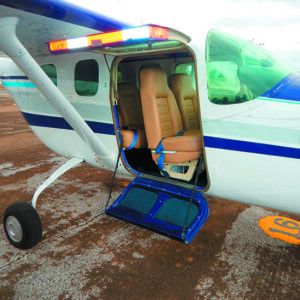
No, Skymasters aren’t blistering fast, but they aren’t slow, either. Turbocharged models do we’ll up in the mid-teens, and normally aspirated models do around 155 to 165 knots true, depending on altitude and how much fuel you want to burn. The turbocharged and pressurized models will easily scoot right along, pushing 190 to 200 knots at 20,000 feet—their maximum certified altitude. At middle altitudes, 170 to 180 knots is typical for the turbo models, which isn’t all that bad.
Since Skymasters have relatively small displacement six-cylinder engines, fuel burn tends to be reasonable, ranging from 15 GPH to 22 GPH total, with 19 to 20 GPH typical for a 150- to 160-knot cruise. For comparison, a Twin Comanche will do about the same speed on 100 fewer horsepower and a lot less gas. Efficiency isn’t a Skymaster hallmark, except when compared to larger, faster twins.
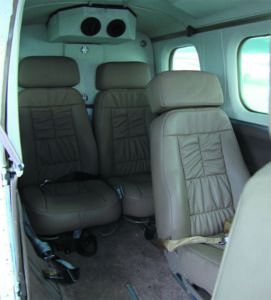
All-engine rate of climb ranges from a modest 1300 FPM in the old 336 to a lethargic 940 FPM with the last 337H models. We’re unaware of any other twin-engine airplane with a book rate of climb below 1000 FPM; even the old 150-HP Apache had a book climb of 1250 FPM with both engines running. On the other hand, lose an engine in a 210 and there’s no rate of climb, only a rate of descent. In a 337, you should at least be able to eke out 200-300 FPM.
Like many Cessnas, runway performance is good. Landing-configuration stall speeds range from 55 to 62 knots, depending on the gross weight of the particular model—about 10 knots below conventional twins like the 310.
As a result, a Skymaster will get off the ground in less than 1000 feet at gross weight—a feat very few other twins can manage. Barrier performance is not quite as good, however; the leisurely climb rate brings the Skymaster’s 50-foot takeoff figures down to the middle of the light-twin pack.
The single-engine climb rates of all the light twins tend to be very similar—200 to 300 FPM—because engine-out climb rate is a certification point around which the airplane is designed. The FAA requires a certain minimum climb, figured by a formula relating to stall speed, and the manufacturers typically bump up the gross weight to the point at which the airplane just barely meets the FAA minimum. Any excess engine-out climb capability is, in effect, wasted payload. And payload numbers sell airplanes.
What’s surprising is the difference between the front and rear engines. Climb on the front engine only is about 50 FPM less than on the rear, but not necessarily for all versions of the Skymaster. Reader Robert Prader once told us his research reveals that later models have better front-engine performance. “It is true that front and rear engine single-engine climb rates are significantly different for all pre-1973 Skymaster models; however, the front and rear single-engine climb rates are not significantly different for the pressurized models and the 1978 and later turbo models,” he said. “If you consult the POH for any pressurized model, you will find that a single-engine climb rate of 375 FPM is listed for a standard day at sea level at gross weight, with no mention of which engine is out. If you consult the POH for the 1980 non-pressurized turbo model, you will find it specifies a climb rate of 335 FPM for the same conditions, again with no mention of which engine is out.”
While leaving the gear down produces a climb penalty of a bit over 100 FPM, raising it carries a temporary 240 FPM hit. (We think this is about average for most twins and probably for single-engine retracts as well.) This is because Cessna’s complicated gear door arrangement adds drag while the gear is in transit. In an after-takeoff engine-out situation, it may be better to leave the gear down, just as it is recommended in some singles to leave it down until obstacles are cleared.
In normal flight, the Skymaster has typical Cessna handling: heavy in pitch, reasonably responsive ailerons. (The P model has especially light ailerons.) Pilots praise its IFR stability. The noteworthy aspect of the Skymaster’s handling—indeed, the whole reason for the airplane’s existence—shows up when an engine fails. Instead of the normal yaw-roll-stall-spin scenario too often following engine failure in “conventional” twins, the Skymaster continues to fly straight ahead. An unprepared or rusty pilot can take his time and concentrate on the task of identifying and feathering the prop on the failed engine, without worrying about losing control.
LOADING, ENDURANCE
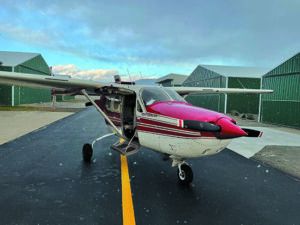
Real-world useful loads run around 1500 pounds—not bad at all, and several hundred pounds more than a Twin Comanche. Standard fuel is 93 gallons, which should leave more than 900 pounds available for payload—plenty for four passengers and their bags. Standard fuel is just adequate, however—unless you throttle back—providing a bit more than three hours with IFR reserves at fast cruise.
Pre-1973 airplanes with long-range tanks had a four-tank fuel system; later ones came with a two-tank system. The long-range tanks—150 gallons in 1975 to 1980 models, 131 gallons in earlier models—solve endurance limitations nicely, at the expense of payload, of course. One owner told us that with long-range tanks full, he has seven-plus hours at 150 knots with 650 pounds of payload (three people and bags). Not a bad compromise.
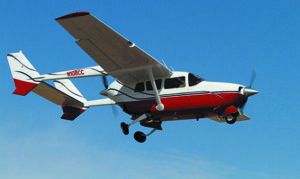
Oddly, the P-337 is allowed only five people; it was certified under different rules requiring an emergency exit in a six-seat airplane. Rather than put in the exit, Cessna simply limited the seating to five. Early P models had a middle seat hinged up and to the side to get at the back row, but these seats didn’t slide fore and aft. Access to the rear seats in other Skymasters requires an awkward scramble over the center row.
The Skymaster’s visibility is excellent—about as good as it gets in any light airplane, single or twin. The view down is unlimited, of course, and the wing’s leading edge is back far enough that it doesn’t block upward vision, either, as with most Cessna singles. Good visibility is not only a safety feature; it adds to the feeling of roominess in the cockpit.
Bring good headsets; the Skymaster is also quite noisy, since the passengers are sandwiched between the engines. Modern interior upgrades with additional (and newer) soundproofing helps. Vibration can also be a problem, particularly without prop synchronizers. Conventional twins are quieter by far.
WRENCHING IT
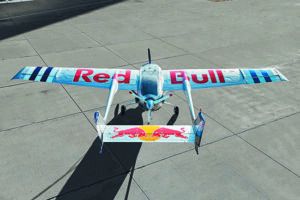
To get an idea of what it takes to really maintain one, consider that the Skymaster was the most complex aircraft ever engineered and manufactured by Cessna’s Pawnee Division, which otherwise built only Cessna singles. Evidence suggests the division simply wasn’t up to the task, particularly in the 1975-1980 period when production was growing rapidly and Cessna was plagued by an epidemic of design, engineering and production problems.
For example, the pressurized Skymaster was initially such a disaster that the first year’s production was recalled to the factory for complete remanufacture and modification. Distinct from other twins, Cessna had to pack everything into the fuselage, not having the luxury of sticking systems out in the wings or into the nose. As a result, access is difficult and it is those systems where most maintenance problems will be found.
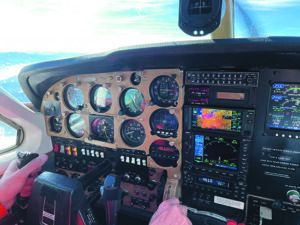
The basic airframe is stout, with a rugged strut-braced wing. There are remarkably few ADs on the airplane. And remember that the military version of the Skymaster did plenty of rough duty in Vietnam, often flying home with bullet holes or worse.
Still, a potential Skymaster nightmare is runaway maintenance costs, particularly in the turbo and pressurized models, so the prudent purchaser will closely examine logbooks and service records of any aircraft under consideration.
The Riley Rocket was a popular Skymaster mod and included upgrades to 310-HP TSIO-520 engines, intercoolers, three-blade props and air conditioning. Rockets come on the market now and again, at a premium price over stock models.
Some shops really work these airplanes over. We’ve seen the Ohio-based Aircraft Sales’ Pristine Airplanes version (www.pristineairplanes.com), which has done the Rocket II full refurb. It adds intercoolers to P337 models, plus new avionics, paint and interior on all models. Including the aircraft, a fully refurbed Rocket II could top $700,000, but like all of the other refurbished aircraft the company pumps out the end result is a like-new aircraft, following almost six months of intense rework.
Other 337 mods include vortex generators from Micro Aerodynamics (www.microaero.com) and intercoolers from American Aviation (www.americanaviationinc.com). Horton (www.stackdoor.com) offers STOL kits and other aerodynamic mods. A wing spoiler kit is available from PowerPac Spoilers (www.powerpacspoilers.com).
Aviation Enterprises (www.cessnaskymaster.com) offers a wide range of parts and major modifications for Skymasters, ranging from air conditioning, airstair doors, extended wingtips, IO-550 engine conversions—for one or both engines—long-range fuel tanks and MT propellers. The company also can provide various parts, including cargo pods. Similarly, R.T. Aerospace (www.rtaerospace.com) offers several items of interest to the Skymaster owner, including a convertible rear seat for the baggage area, a composite cargo pod and baggage door retrofit. One of the major drawbacks of the Cessna Skymasters is that due to the rear engine position, the fuselage design does not allow for a baggage compartment. That means stuffing things wherever you can find room.
The R.T. Aerospace pod (which weighs 36 pounds) solves the issue, providing for 300 pounds of capacity, with over 13 cubic feet of storage space. The pod measures 38 inches wide, 92 inches long and 15 inches deep on edge, with a 9.25-inch usable height due to fuselage contour. The door opening measures 29.0 x 11.25 inches. Ground clearance with the pod installed is 9.0 inches. See the image at the top of the next page for a visual.
The Cessna Pilots Association (www.cessna.org) is building back up and is a good source for tech data on Skymasters, as is www.cessnaflyer.org. There’s also a decent Skymaster website at www.337skymaster.com, plus the Cessna Skymaster Fans group on Facebook.
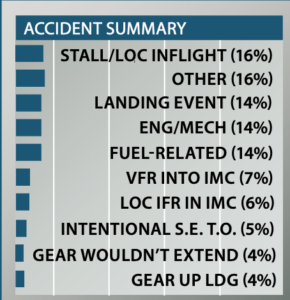
Our review of the 100 most recent Cessna 337 series wrecks confirmed much of what we’ve thought about the aircraft as we’ve flown them over the years. On the good side, they have nearly perfect manners on the runway—there were but two runway loss of control (RLOC) events.
However, fourteen pilots had difficulty on landing—among them, one hit short of the runway, seven hit hard and/or bounced enough to damage the airframe and two landed with a tailwind, we’ll down the runway, and went off the end.
The problems we saw were on the human side of the human/machine interface. Where the cause of engine power losses could be ascertained, it was almost always failure to perform maintenance. One owner did nothing but annual his airplane and add oil to the engines. There was no record of any work of any sort on them. His benign neglect policy worked until one engine put a connecting rod through the case. Unfortunately, the owner hadn’t practiced his single-engine work, couldn’t figure out how to hold altitude and wrecked the airplane.
Another fourteen pilots ran their airplanes out of fuel. It appears that none did anything to visually confirm the fuel quantity.
There were only four accidents resulting from an inability to extend the landing gear. In one, the hydraulic line that connected to the reservoir was so badly corroded that the hydraulic fluid leaked out.
Sixteen pilots lost control of their Skymaster in VFR flight—a high number in our opinion. The majority involved a stall, usually shortly after takeoff or a go-around. Several involved maneuvering aggressively at low altitude or in the pattern and three were pilots who had blown a landing, were trying to go around and couldn’t get the airplane collected before putting a wingtip into the ground. Six pilots lost control on an instrument flight plan in IMC, although two of those involved thunderstorms.
We have a hypothesis that a certain set of pilots is attracted to airplanes designed to be “safe” such as the Skymaster and Ercoupe. They rely on the safety built into the airplane rather than a willingness to maintain their skills and often show poor judgment, anticipating that the airplane will save them.
We think evidence in support of the hypothesis appeared in the five pilots who faced a nonfunctioning engine and rather than get it fixed, elected to make a single-engine departure. None survived.
A pilot with no multi-engine time, and who hadn’t flown in eight years, bought a Skymaster. He started a FR with a CFI in a 182, but was unable to complete it because of his level of performance. He then put his family into the Skymaster and set out on a long trip. He flew into a line of thunderstorms, lost control and the aircraft broke up.
A pilot making a high-speed low pass 30 knots above maneuvering speed began an enthusiastic pull up—and fractured both wings.
We were nonplussed by the pilot flying at 900 feet off the California cost who had the front engine quit. He got it restarted but was down to 500 feet. With two working engines, rather than climb, he extended the landing gear and ditched his Skymaster into the Pacific.
FEEDBACK
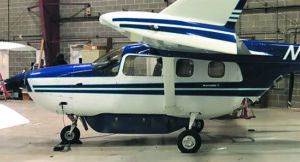
I have owned over 30 airplanes and six of them were Cessna 337 Skymasters, to include two 1968 models, a 1975 and 1973 model and currently a 1971 337F model. All were great-running normally-aspirated models, with the exception of the 1969 model, which was a hanger queen. I am a 6-foot-6-inch former NBA player and let me tell you, Cessna is to be commended for thinking of the tall pilots when they designed this tough airplane. I think it’s a dream to fly for the owner-pilot who doesn’t fly every day for a living.
After leaving pro basketball I became a jazz recording artist, reality-television Dad and motivational speaker. I am based near Nashville, Tennessee, with vacation homes in Destin, Florida, Atlanta, Georgia and Detroit, Michigan. With my active career schedule and homes in varying states, private aviation is not a want-to but a “have to” activity. As do many pilots, I have a bad habit of reading airplane classified ads and the “grass is greener” bug has bit me several times. I have jumped the fence and owned a Cessna 421, 401, 320, 207, 206, 210, Piper Navajo, Piper Aztec, Piper Cherokee Six and a Beech Queen Air (ouch). But by far the absolute best twin-engine airplane I’ve owned is the Cessna 337 Skymaster. The best single was a Piper Lance.
I would buy something bigger, then return to the 337. I would buy something faster, then return to the 337. I would buy something prettier, then return to the 337. The 337 always got the job done. Unfortunately some negative comments about the 337 come from pilots who haven’t owned the airplane. I can testify my truth on the following Skymaster urban legends:
The rear engine does not overheat—ever—the cabin is not noisy since it sits between two engines, it’s not hard to recognize you’ve lost the rear engine if you’re paying attention and last, it’s not really a maintenance hog if you keep it well-maintained to start. If you buy a 337 that has been sitting, you could pay between $7000 and $15,000 for the first annual inspection, and around $5000 for the next ones. It’s imperative to bring it to a mechanic who knows the 337 well.
For performance, plan for 160 knots and over five hours of endurance with the 128-gallon fuel tanks. Keep it simple and run it 24-squared on 20 GPH, block-to block. Visibility is great for all passengers, as is the ventilation and heat. Long-legged rear passengers would prefer 1976 and later models because the seat tracks were realigned to allow the passenger bench to roll farther back, giving more legroom.
Rear legroom would be my only complaint with the Skymaster. My 6-foot-tall wife loves the roomy rear cabin in our Piper Lance, which we fly only for day VFR trips. The 337 is reserved for night, IMC and over-the-water trips.
I love the safety aspect of the centerline thrust, although I’ve never had a real engine failure. But I have been in lots of weather, updrafts, downdrafts and turbulence and the 337 has proven to be a military-grade workhorse.
Ben Tankard – Murfreesboro, Tennessee
In the 1970s I was Cessna’s West Coast multi-engine sales manager.
My company car was often a T337 or P337. The Skymasters were we’ll equipped and had fewer than 100 hours flown. I supported Cessna’s multi-engine dealers in Arizona, California and Nevada with sales, training and customer demo flights.
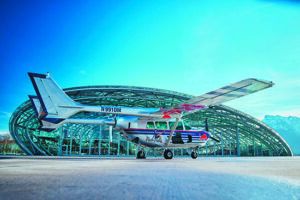
Just as today’s whole-airplane parachutes or Garmin’s Autoland system can secure the sale, on demo flights when I’d shut down the front engine and feather the propeller with the blades horizontal, the potential owner (or non-flying spouse) was sold. Unfortunately, it would seem to me that these airplanes are slowly evolving into an orphaned status because many shops that are Twin Cessna maintenance specialists might not work on them. The Twin Cessna Flyer Organization hasn’t recently included the Skymasters in its owner seminars or in its recent magazine tech articles.
I would advise a potential Skymaster buyer to conduct due diligence and speak with experienced Skymaster mechanics. It’s also worth paying for some flight time to get a feel for the airplane, and of course a thorough prebuy evaluation.
That said, the Skymasters are sound multi-engine airplanes, and could be a good match for a pilot seeking a twin, yet without having to deal with some of the operational issues associated with conventional twin models.
When checking out pilots in the Skymaster, I modified the checklist in several places. I made it clear that although it has centerline thrust, it is still a multi-engine airplane, and you should always “think twin.” Point is, training should always emphasize both multi-engine and single-engine climb performance with the landing gear up, down and in transit, just as you would in a conventional twin.
Last, for those interested and to see what these airplanes look like in action, in the 1988 movie BAT 21 the star aircraft was a USAF 02A Forward Air Controller. Plus, a detailed history of the Skymaster is outlined in William D. Thompson’s Cessna: Wings for the World II and in Walt Shiel’s Cessna Warbirds.
Jerry Temple – Jerry Temple Aviation, Frisco, Texas

